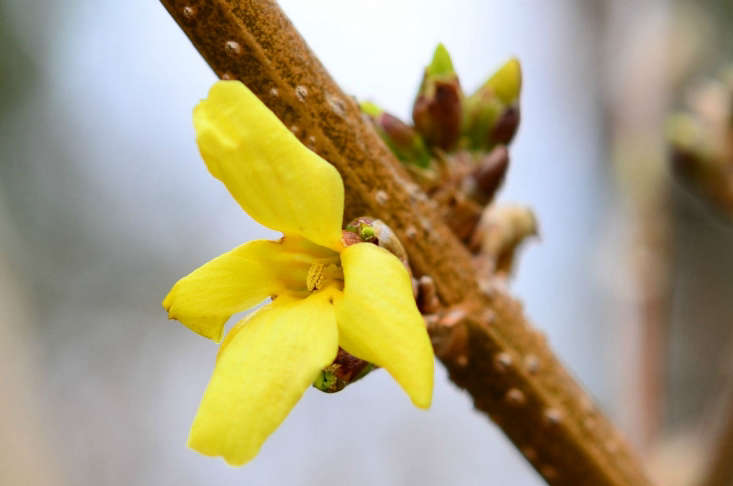Forsythia, Forsythia x intermedia: Border Forsythia
Even people who can’t tell a cactus from a tulip can recognize Forsythia. It is that ubiquitous big shrub that often looks like an untidy bunch of sticks until early spring, when it suddenly reveals its raison d’être with an explosion of brilliant yellow flowers.

Garden designers sometimes avoid this plant because it only provides interest in the landscape during one season. The rest of the time, according to them, it just sits there taking up too much space. Well, yes and no. While it is true that Forsythia does not have a dramatic appearance except for the two or three weeks when it is in bloom, this plant definitely has strengths and can perform some valuable functions in the garden. And it is totally reliable, even if your thumb is so far from green that it is as black as a lump of coal.

For instance, this native of China and Korea is so tough that it can survive not only benign neglect but also violent and possibly malevolent maintenance. In my neighborhood there is a row of Forsythia plants on a litter-strewn strip of compacted land next to a parking garage. Once a year someone wielding a brutal weapon, perhaps a chainsaw, viciously decapitates the tops of these shrubs, splintering their branches and destroying their natural shape. Yet each and every spring these hardy survivors transcend their site and their treatment and bloom like champs.

Cheat Sheet
- Forsythia grows quickly, gaining as much as 24 inches in height a year, so plan ahead and put it where it will have plenty of room to grow 12 feet wide by 10 feet high (its typical mature size).
- Use this plant as a specimen (Weeping Forsythia, Forsythia suspensa var. sieboldii, is especially effective for this purpose), in multiples as a screen or hedge, espalier it against a wall or fence—but don’t use it as a foundation planting where it will soon be too big and unruly.
- To increase the season of bloom, cut branches when buds swell in very early spring and bring them inside for forcing. You can make a long slanting cut at the end of the stem or smash it with a rock or brick so it will take up plenty of water and give you a beautiful preview of what you will soon see outside.

Keep It Alive
- Forsythia is hardy from growing zones 5 to 9. It will tolerate full sun to partial shade but needs at least six hours of full sun for vigorous bloom.
- Forsythia will tolerate most kinds of soil if it drains well. This plant does not thrive in soggy conditions but, once established, will tolerate drought.
- After buds have formed in the early spring they are vulnerable to late frosts. Keep your eye on the forecast and, if severe weather looms, drape your plant with burlap or horticulture cloth to keep from losing the season’s bloom.

Forsythia is one of those plants, like crape myrtle, with such a beautiful natural form that it is extremely important to prune it correctly. It flowers on old wood so pruning needs to be done soon after flowering before buds begin to form for next year’s flowers. Experts advise removing about a third of the canes each year. Choose the oldest and tallest and cut them close to the ground, never high up or in the middle. Also remove any dead or damaged canes and ones that cross and rub against each other. Low-hanging branches will root readily if they come in contact with the soil, so remove them to keep your plant from spreading. Thinning branches from the middle of the plant will let in light and encourage new growth.

Forsythia is long-lived, but if your plant is old and is no longer blooming as robustly as it used to, you may want to sacrifice a year’s flowers and rejuvenate it by cutting the whole shrub back to the ground. This is best done in late fall and is almost guaranteed to give you a fresh new crop of branches that will flower vigorously when they mature the next year.
If you love this plant but have only limited space to grow it, consider using one of its many dwarf cultivars. They will give you that jolt of spring color, but typically grow only 2 to 3 feet tall with only half the 12-foot spread of Border Forsythia. Some recommended varieties are “Arnold’s Dwarf,” “Goldilocks” and “Gold Tide.” For even smaller gardens there is a flowering ground cover, Forsythia viridissima “Bronxensis,” which grows to only a foot high with a 2 to 3 foot spread.
N.B.: To see more of our favorite flowering shrubs and hedging plants, browse our Shrubs: A Field Guide or see our growing guides:












Have a Question or Comment About This Post?
Join the conversation (4)